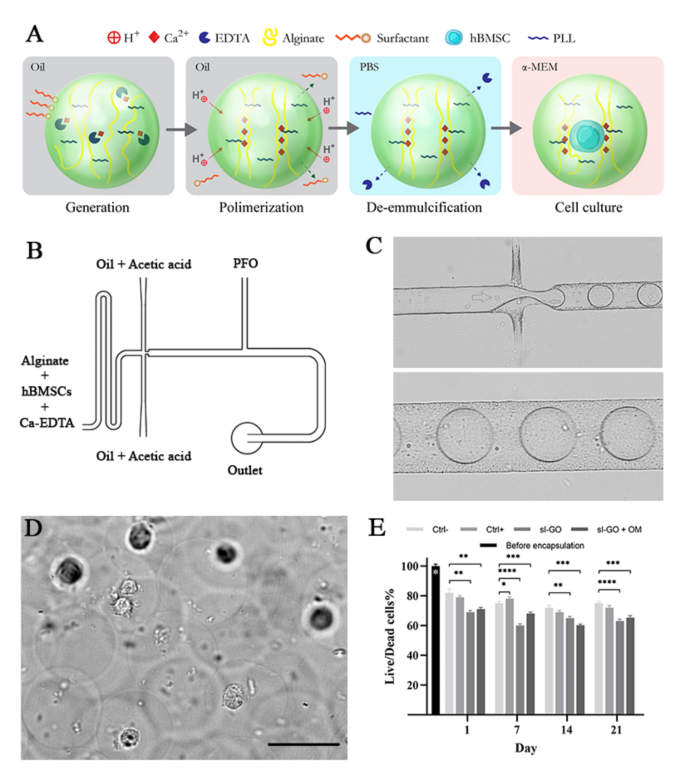Researchers have discovered an innovative approach to using graphene oxide (GO) nanosheets to enhance the regenerative potential of human bone marrow-derived mesenchymal stem cells (hBMSCs). By encapsulating these stem cells within alginate microgels, the team found that the addition of single-layer graphene oxide (slGO) significantly improved the cells’ viability, proliferation, and differentiation into bone-forming osteoblasts. This groundbreaking research opens up new possibilities for developing minimally invasive, injectable tissue transplants that could revolutionize the field of bone regeneration and tissue engineering. Graphene, Mesenchymal stem cells, Bone regeneration, Tissue engineering
Main Content:
Harnessing the Power of Graphene Oxide for Bone Repair
Graphene oxide (GO) has emerged as a revolutionary nanomaterial with tremendous potential in the field of biomedicine. Its exceptional properties, including biocompatibility, high hydrophilicity, and numerous oxygen-containing functional groups, have made it a promising candidate for applications ranging from biosensors and drug delivery to tissue engineering and regenerative medicine. In particular, researchers have been exploring the use of GO as a powerful tool for enhancing the differentiation of stem cells, especially in the context of bone tissue engineering.
Encapsulating Stem Cells in Alginate Microgels
One of the key challenges in stem cell-based therapies for bone repair is maintaining the survival and directed differentiation of the transplanted cells. To address this, the research team developed a microfluidics-based approach to encapsulate human bone marrow-derived mesenchymal stem cells (hBMSCs) within alginate microgels. This technique allows for the precise and continuous production of monodisperse, cell-containing microgels that mimic the natural extracellular matrix (ECM) and provide a protective, 3D microenvironment for the cells.

Enhancing Stem Cell Fate with Single-Layer Graphene Oxide
The researchers then investigated the impact of incorporating single-layer graphene oxide (slGO) nanosheets into the alginate microgels. Their findings revealed that the presence of slGO significantly enhanced the viability, proliferation, and osteogenic differentiation of the encapsulated hBMSCs. The slGO-containing microgels exhibited increased porosity, roughness, and reduced stiffness compared to the alginate-only microgels, which are all favorable characteristics for promoting bone tissue formation.

Unlocking the Osteogenic Potential of Stem Cells
The team’s analysis of gene expression patterns demonstrated that the encapsulated hBMSCs in the presence of slGO showed significantly higher levels of key osteogenic markers, such as osteocalcin (OCN), runt-related transcription factor 2 (Runx2), and alkaline phosphatase (ALP). These findings suggest that the unique structure and composition of the slGO nanosheets can interact with the cells, leading to enhanced intracellular signaling and the activation of osteogenic differentiation pathways.

Towards Minimally Invasive Bone Regeneration
The ability to encapsulate and differentiate stem cells within injectable, biocompatible microgels offers a promising approach for developing minimally invasive tissue transplants for bone repair. The alginate-slGO microgels demonstrated excellent cell viability, proliferation, and osteogenic potential, making them an attractive candidate for future clinical applications in bone regeneration and tissue engineering.

Expanding the Frontiers of Stem Cell Therapy
This study represents a significant advancement in the field of stem cell-based therapies for bone repair. By leveraging the unique properties of graphene oxide, the researchers have found a way to enhance the regenerative capacity of mesenchymal stem cells, opening up new avenues for developing more effective and personalized treatments for a wide range of bone-related injuries and disorders. As the scientific community continues to explore the versatile applications of graphene-based materials, this breakthrough research highlights the immense potential of harnessing these innovative nanomaterials to unlock the full regenerative potential of stem cells.
Author credit: This article is based on research by Hossein Soleymani, Mehrdad Moosazadeh Moghaddam, Hossein Naderi-Manesh, Ramezan Ali Taheri.
For More Related Articles Click Here
